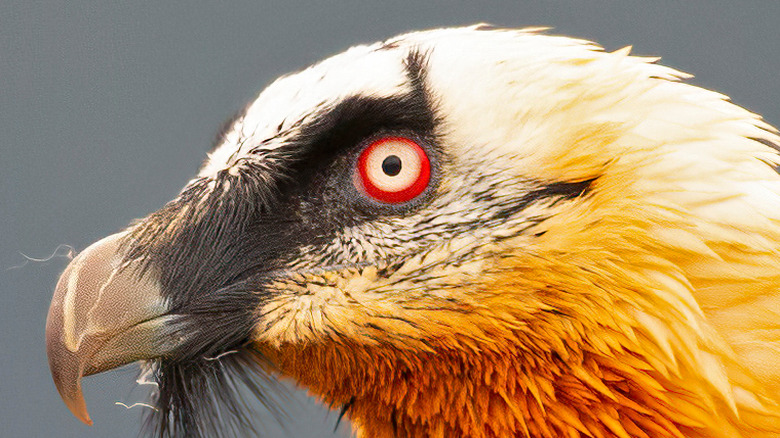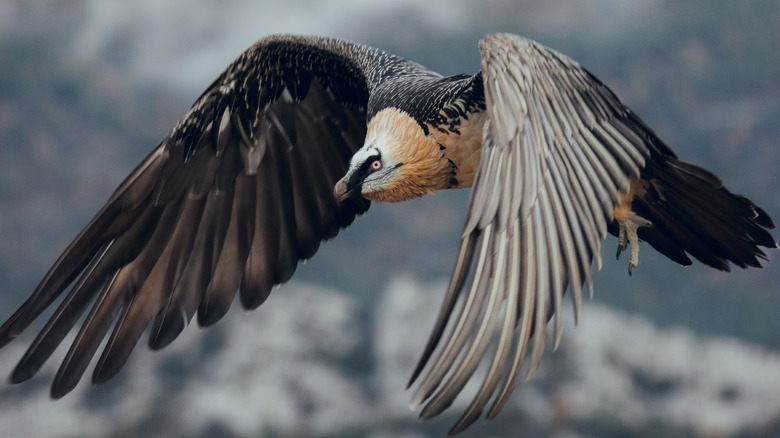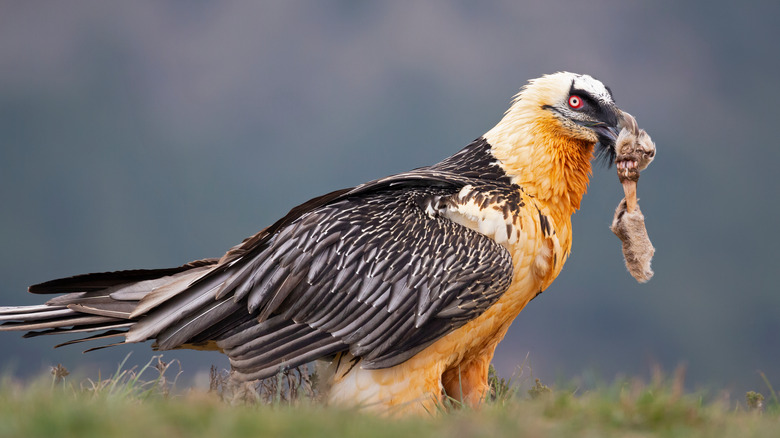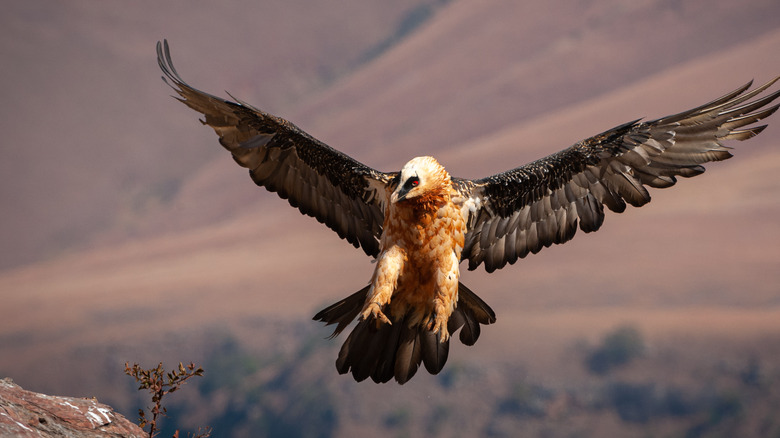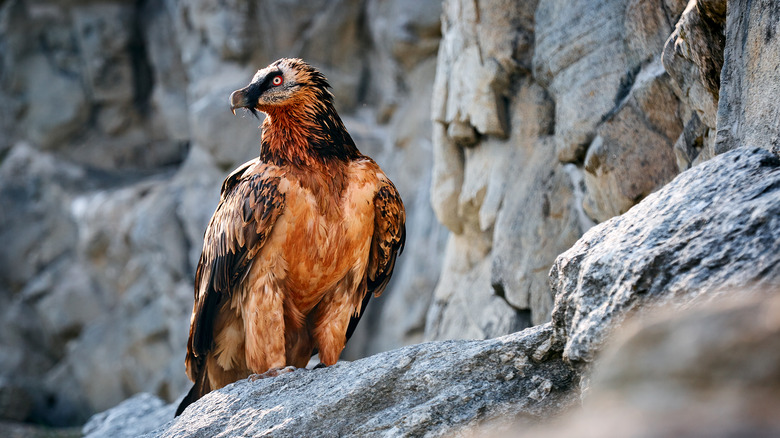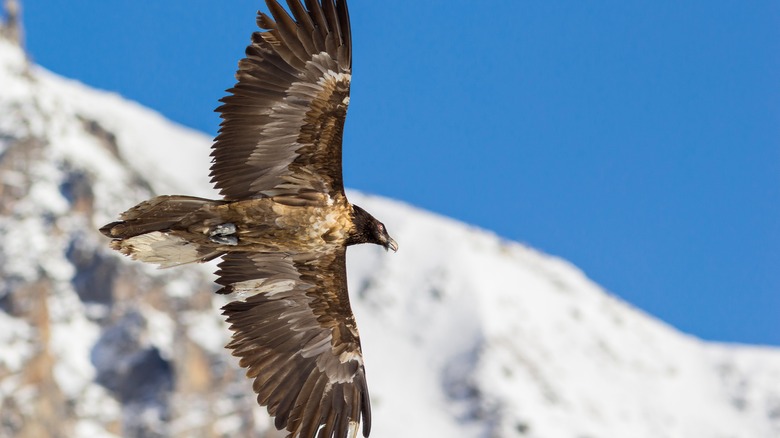The Bird With The Bizarre Bone-Eating Diet
Vultures have earned something of a bad rap. The birds, which are found in all continents except Australia and Antarctica, are scavengers who primarily eat the flesh of dead or dying animals instead of hunting for themselves, according to Britannica. Sometimes, when there is a food source — i.e., a dead body — nearby, vultures can be seen circling in the sky, preparing to feed, according to AZ Animals. This has led vultures to develop a reputation as a bad omen. In fact, the word "vulture" now has a double meaning. In addition to referring to birds, the term can mean "a rapacious or predatory person," according to Merriam-Webster.
But the vulture's status as a scavenger wasn't always so well known. In Europe, people once believed that one type of vulture, the bearded vulture, hunted live prey, according to the Vulture Conservation Foundation. Thinking that the bearded vultures were attacking lambs and even small children, people hunted the bearded vulture until it was eradicated from the Alps entirely. But the truth about the bearded vulture's diet is even stranger. This bird isn't just a garden-variety scavenger: it's the only animal that feeds primarily on bone (via the World Wildlife Fund).
What does the bearded vulture look like?
The bearded vulture is an Old World vulture, meaning it can be found in Europe, Africa, and Asia, according to Britannica. Bearded vultures make their homes as far south as South Africa, and as far north as France and Germany.
A large bird, the bearded vulture can have a wingspan of up to 10 feet, and can weigh over 15 pounds, according to the Vulture Conservation Foundation. The baby bearded vulture has dark brown feathers, but as these birds mature, more and more of their feathers turn white. However, they don't stay white. Vultures bathe in bodies of water with high iron content, which lingers on their wings and oxidizes. That means their "white" feathers tend to look more red or orange in appearance. As adults, bearded vultures usually mate in monogamous pairs. There are currently around 600-800 pairs of breeding bearded vultures in the wild.
The bearded vulture's strange diet
Hands down, the bearded vulture's unique feature is its strange diet. Bearded vultures, like all vultures, are scavengers which search for and consume dead animals, including remnants of other predators' meals. However, the bearded vulture is the only vulture which primarily eats bone (via the World Wildlife Fund). It's believed that 95% of the vulture's diet is composed of bone, according to Wired.
The bearded vulture can swallow some bones whole, according to the Vulture Conservation Foundation. Their stomach acid is so strong that they can digest bones in as little as 24 hours, writes Africa Freak. But bearded vultures can also eat bigger bones that are too large for them to swallow whole. The vultures simply pick up the bone and fly upward, then drop the bone onto a rock. They repeat this process until the bone shatters, at which point they consume the fragments.
Evolutionary advantage of eating bones
But why would a bird evolve to have an all-bone diet? Although this kind of diet is unconventional, it actually has quite a few benefits. Bones are quite dense in nutrients and calories, according to Wired. Bone marrow, found inside of bones, is high in fat and can fuel vultures for a long time. And the bone itself has plenty of nutrients, like calcium, which the vulture can digest with its strong stomach acids.
Another benefit of relying on bones for food is the lack of competition, according to the World Wildlife Fund. As the only animal in the world which primarily subsists on bone, and one of the few animals whose stomach acid is capable of digesting bone, bearded vultures are usually easily able to find bones to eat. Bearded vultures can obtain bones from abandoned carcasses, even those that have been sitting around for months, and from the bodies of animals who died of starvation, according to Africa Freak.
How the bearded vulture was dangerously hunted
While there are currently many bearded vultures in Europe, this wasn't always the case. At one point, the bearded vulture was eradicated from some regions of Europe, including the Alps, after a series of incorrect myths spread about the bird, according to the Vulture Conservation Foundation. In the 19th century, people began to believe that vultures hunted and killed lambs, which were grown as livestock, and even worried that vultures were hunting toddlers and infants. As a result of this misinformation, the bearded vulture was hunted until it was almost eradicated from Europe, with the last one in the Alps shot in 1913. After that, the hunting continued in other regions in Europe, with the birds almost eradicated from Eastern Europe by the 1990s, according to Mental Floss.
Today, though hunting of bearded vultures is no longer permitted, other threats continue to threaten their survival. Some of these threats include habitat destruction, loss of food sources, and poisoned baits which, though intended for other animals, sometimes attract vultures, with fatal results.
The efforts to reestablish bearded vultures in Europe
Luckily, there are plenty of habitats outside of Europe where bearded vultures were not eradicated and where they continue to live. These areas have functioned as a reservoir for the species and have led the International Union for Conservation of Nature to classify the endangerment status of the birds as "least concern." However, in Europe, conservation efforts have had to be implemented to bring bearded vulture populations back up to early 19th-century levels.
Around 100 breeding pairs of bearded vultures currently exist in Europe, with some of them being birds reintroduced to the ecosystem through environmental programs, according to Bird Watching Daily. These efforts include the Alpine Reintroduction Project, which, beginning in the 1970s, aimed to bring bearded vultures back to the Alps, according to the Vulture Conservation Foundation. Now, about 20 pairs of breeding vultures can be found in the Alps, and the numbers are continuing to steadily increase throughout Europe. Similar efforts have been started in Spain, including the Andalucia Reintroduction Project and the Valencia Reintroduction Project.
